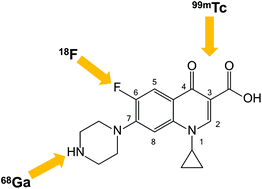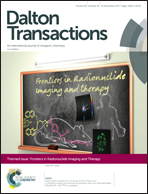Fluoroquinolones as imaging agents for bacterial infection
Abstract
Diagnosis of deep-seated bacterial infection is difficult, as neither standard anatomical imaging nor radiolabeled, autologous leukocytes distinguish sterile inflammation from infection. Two recent imaging efforts are receiving attention: (1) radioactive derivatives of sorbitol show good specificity with Gram-negative bacterial infections, and (2) success in combining anatomical and functional imaging for cancer diagnosis has rekindled interest in 99mTc-fluoroquinolone-based imaging. With the latter, computed tomography (CT) would be combined with single-photon-emission-computed tomography (SPECT) to detect 99mTc-fluoroquinolone-bacterial interactions. The present minireview provides a framework for advancing fluoroquinolone-based imaging by identifying gaps in our understanding of the process. One issue is the reliance of 99mTc labeling on the reduction of sodium pertechnetate, which can lead to colloid formation and loss of specificity. Specificity problems may be reduced by altering the quinolone structure (for example, switching from ciprofloxacin to sitafloxacin). Another issue is the uncharacterized nature of 99mTc-ciprofloxacin binding to, or sequestration in, bacteria: specific interactions with DNA gyrase, an intracellular fluoroquinolone target, are unlikely. Labeling with 68Ga rather than 99mTc enables detection by positron emission tomography, but with similar biological uncertainties. Replacing the C6-F of the fluoroquinolone with 18F provides an alternative to pertechnetate and gallium that may lead to imaging based on drug interactions with gyrase. Gyrase-based imaging requires knowledge of fluoroquinolone action, which we update. We conclude that quinolone-based probes show promise for the diagnosis of infection, but improvements in specificity and sensitivity are needed. These improvements include the optimization of the quinolone structure; such chemistry efforts can be accelerated by refining microbiological assays.

- This article is part of the themed collections: Frontiers in Radionuclide Imaging and Therapy and 2017 Frontier and Perspective articles


 Please wait while we load your content...
Please wait while we load your content...